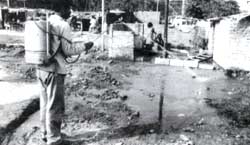Lethal gambit
 WITH the ministry of health and family welfare ready to launch a major offensive against malaria from June 1, the country is in for another dose of one of the most toxic chemicals known to humans: dichlorodiphenyl trichloroethane (DDT). Health minister Saleem Sherwani recently announced the setting up of a special committee to monitor measures to eradicate malaria.
WITH the ministry of health and family welfare ready to launch a major offensive against malaria from June 1, the country is in for another dose of one of the most toxic chemicals known to humans: dichlorodiphenyl trichloroethane (DDT). Health minister Saleem Sherwani recently announced the setting up of a special committee to monitor measures to eradicate malaria.
Despite the ban on use of benzene hexachloride (BHC) in agriculture and for vector control, the use of chemicals like DDT is still widely prevalent in public health services. According to an estimate, about 10,000 metric tonnes Of DDT is produced annually in India for vector control. Before the ban, DDT and BHC represented 70 per cent of the total pesticides consumed in the country. Of this, 80 per cent of the DDT and 40 per cent of the BHC was used to control breeding of mosquitoes under the National Malaria Eradication Programme (NMEP). BHC was only recently withdrawn from use.
The World Health Organization (WHO) has termed DDT as a Class moderately hazardous pesticide". According to Health Hazards of Pesticides and its Management, a Voluntary Health Association of India (VHAI) publication, the possible effects of DDT include cancer, ill-effects on reproductive health and liver damage. It has also been proved that DDT is non-biodegradable, is passed on through the food chain, and accumulates in body fat. In fact, DDT has been found in significant and sometimes dangerous levels in mother"s milk. Contact with clothes made from plant fibres containing residues of DDT can also introduce the chemical into the body. During the Somoza regime in Nicaragua, heavy applications of DDT on cotton resulted in contamination of human breast milk: in urban areas, the chemical was found in mothers" milk at levels 42-45 times above the WHO"s "safe" level.
Yet DDT continues to be used indiscriminately in India. Says Sanjoy Sengupta of the VHAI, "DDT enters the food chain through air, soil and water. We should discourage the use of such chemicals."
Anomalies are rampant even in the agricultural sector. It is alleged that in spite of the ban on Use of DDT in agriculture, it is still being used by farmers since it is easily available in the market. As Sengupta points out, "Laying down a law does not automatically restrict use of a toxic pesticide."
Insecticides and chemical larvicides with a long life have been the mainstay of the malaria control programme. DDT, BHC and malathion are the main pesticides used under the NMEP. Synthetic pyrethroids like allethrin and lambda cyhalothrin, not considered as harmful as organochlorides, have also been used in vector control. But tests have shown that even synthetic pyrethroids have some toxic effects on aquatic life. Safe, traditional and alternative methods to curb malaria have been given the go-by.
Before DDT arrived on the scene, people across the world used various methods to curb malaria including draining swamps, covering pools of standing water with oil and installation of screens in residences. These techniques were highly effective, reducing mortality due to malaria substantially.
Alternative methods include use of potent larvicidal agents and fish that control the breeding of mosquitoes. For example, strains of Bacillus sphaericus remain toxic for mosquito larvae for six to nine months and have a lethality of 90 per cent, according to researchers in Thailand. In Pondicherry, India, species of fish such as Gambusia affinis and Aplocheilus blochii have been found to reduce breeding of anopheles mosquitoes in wells from 32.8 per cent to one per cent in a month.
In view of the well-known advantages of biological control methods, Sengupta avers that it is better to go in for "a proper mix of environmental management and the use of biological pesticides". But with the government loath to do away with DDT, a chemical banned as far back 1972 in the us, the killer pesticide continues to stalk urban and rural India.
| Deadly doses supply of pesticides under the NMEP | ||||
| Pesticide | Strength (per cent) | Quantity supplied to the states by NMEP in metric tonnes | ||
| 1993-94 | 1994-95 | 1995-96 | ||
| DDT | 50 | 8,792.30 | 8,81.25 | 8,998.00 |
| BHC | 50 | 7,779.50 | 6,305.00 | 5,784.00 |
| Malathion | 25 | - | 700.00 | 350.00 |
| Synthetic pyrethroids | - | NA | 141.00 | 149.00 |
| DDT: dichlorodiphenyl trichloroethane BHC: benzene hexachloride NA: not available NMEP: National Malaria Eradication Programme | ||||
